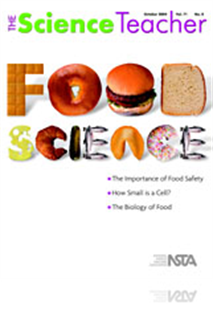All Resources
Journal Article
Commentary: Educating the Public on Food Safety
In 1993, the Pacific Northwest witnessed an outbreak of the pathogen Escherichia coli (E. coli) 0157:H7 from undercooked, contaminated hamburgers served at Seattle-area Jack in the Box fast-food restaurants (Golan et al. 2004). This foodborne illne...
Journal Article
Science Sampler: Collecting artifacts
A new science teacher commissioned students to help build a collection of artifacts related to science. As the project evolved, the teacher was able to cover material across the curriculum and show how closely different areas are intertwined. By enco...
Journal Article
Editor's Corner: Food for Thought
Food issues often appear in the news and other media. For example, the media regularly address food safety concerns—from Bovine Spongiform Encephalopathy (BSE) or “Mad Cow Disease” to Salmonella and Escherichia coli (E. coli) outbreaks. Obe...
Journal Article
Scope on Safety: Fire safety fundamentals
Planning and prevention is the best defense against fires in school. This is particularly true in the science laboratory due to the presence of flammable gases, liquids, combustibles, and other potential sources of fire. This article outlines prudent...
Journal Article
Methods and Strategies: Reaching English Language Learners
The “hands-on” nature of science motivates and encourages students to interact with others, which can be especially good for English Language Learners (ELL). These basic strategies will benefit all students....
Journal Article
Instead of tedious labeling of rocks, geology is a dynamic, relevant field that in many ways provides a context and connection for all other fields of science. This selection includes notes from the field editor of Science and Children regarding the...
Journal Article
Science Sampler: Creative projects stimulate classroom learning
In a perfect world, what would a good classroom strategy look like? It would definitely include the use of projects. Classroom projects are original pieces of student work that may be in the form of art, writing, models, experiments, and various othe...
Journal Article
This case explores the aggressive mimicry behavior of “femmes fatales” fireflies—female fireflies in the genus Photuris that mimic the flash pattern of females in the genus Photinus to lure Photinus males to their death. The case features entri...
Journal Article
Was the Great Pyramid Built with Simple Machines?
In this integrated science and social studies lesson, fifth-grade students participated in hands-on activities using simple machines and speculated how the pyramids were built. Students extended the experience by designing a machine that has the pote...
Journal Article
The Genetics and Evolution of Human Skin Color
This case explores the genetics and evolution of skin color, using a short story by Kate Chopin called “Desiree’s Baby” as a starting point. Students read the story and discuss a series of questions probing the genetics of the family in the tal...
Journal Article
Science Sampler: Successful lab reports through model analysis
Despite your best efforts, are the majority of your middle school students unable to write detailed, complete lab reports? If your answer is a resounding “yes,” try implementing Model Analysis into your science curriculum. This strategy effective...
Journal Article
Idea Bank: Using Food Science as a Thematic Unit
While rethinking the math and science program for ninth- and tenth-grade high school students, the authors found that the math, English, and social studies teachers had the same goal—to maximize learning in all subject areas. To help meet this goal...
Journal Article
The human race is learning to live with the restless nature of Earth. Thanks to the work of Earth scientists, we can forecast and prepare for many natural hazards in an effort to minimize the loss of life and property. In celebration of the work Eart...
Journal Article
The physical demands of the Tour de France and the success of American cyclist Lance Armstrong provide a great "hook" to teach middle school students about nutrition and physiology. This article describes how an ordinary nutrition and physiology un...
Journal Article
Through the following inquiry-based activity involving yeast, students learn about cell size in a way they will never forget. Essentially, each student or lab group is given one grain of active dry yeast, is asked to estimate the number of cells in t...
Journal Article
Science Shorts: Going Through Changes
Earth's surface is always changing. Much of that change happens because of air, wind, water, and temperature differences. If you have ever observed mud and rocks being carried along by a stream of water after a heavy rain, you have observed the Ear...
Journal Article
Accidental Drowning or Foul Play?
This case was developed for a sophomore organic chemistry lab to illustrate how a combination of techniques is usually required in the identification of chemical compounds. It involves a murder mystery with a forensic twist: Two bodies have been reco...
Journal Article
Editorial: An Inside Peek at a Case Study Workshop
Here we are again with another special issue of JCST devoted to using case study teaching in the science classroom. These cases are the product of the annual workshops presented by the National Center for Case Study Teaching in Science at the Unive...






